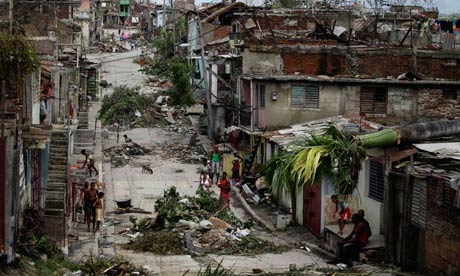 Before it landed on the coast of the USA, Hurricane Sandy had already affected the Caribbean, with massive destruction being left in its wake in Haiti, Jamaica and Cuba.
Before it landed on the coast of the USA, Hurricane Sandy had already affected the Caribbean, with massive destruction being left in its wake in Haiti, Jamaica and Cuba.
The storm landed on eastern Cuba on 25 October, by which point 330,000 people had been evacuated, including 3000 agricultural workers working on the coffee harvest. Despite the evacuation, 11 people were killed by the storm which had a maximum wind speed of 175 km per hour. In total, 200,000 homes have been damaged by the hurricane and extensive damage was done to the electricity and telecommunications infrastructure of Holguin and Santiago de Cuba, the two provinces most affected.
The city of Santiago de Cuba faced the eye of the storm and historic landmarks in the heart of the city, such as the Tomás Romay and Emilio Bacardí Museums of Natural History, were affected by the storm. Agriculture was heavily affected , with crops being destroyed or damaged in the eastern provinces. Officials have estimated the economic cost of the hurricane as at least $88 million in the province of Santiago de Cuba alone.
Since the storm there has been an outpouring of international solidarity. Bolivia has promised 120 tonnes of food and water, with the first shipment of 60 tonnes leaving on 3 November. On 1 November, Russian aid reached Santiago de Cuba, which included building materials. Venezuela has been among the first to deliver aid to Cuba and Haiti, with 14 tons of food arriving on 1 November and further aid of food, water, and equipment to aid in the recovery process coming afterwards.
Recovery underway in socialist Cuba
The recovery process within Cuba has been outstanding. In the aftermath of the storm, workers brigades were sent to help with the clear up and recovery program in Holguin and Santiago de Cuba, These included 350 brigades of electricians working to restore power and telephone services as well as army troops.
Roads which had been affected by falling trees were reopened in Santiago de Cuba by 30 October and by the 31 October 73% of the electricity services in Holguin were restored according to the Ahora newspaper. By 29 October, nearly all classrooms had reopened in Holguin province as, despite 1475 schools being structurally damaged by the hurricane, alternative sites were found.
On 28 October, President Raul Castro visited Santiago de Cuba to show support for the recovery efforts. Prior to the visit, in a meeting with the vice president of the Ciego de Avila Provincial Defence Council, Raul commented:
“This readiness of the people of Ciego de Avila and all Cubans to help their compatriots in the east of the country with the human and material resources needed is impressive.”
This has been further confirmed by the announcement of The National Small Farmers Association of Cuba (ANAP) on 29 October to double the efforts to recover agricultural production in the cooperative sector to make up for the damage caused by the hurricane and the allocation of resources to increase production of transformers and other electrical equipment necessary in the full re-establishment of power in the eastern provinces by the Cuban government.
The planned evacuation of thousands of people and the concerted, unified response to the disaster in socialist Cuba contrasts deeply with the situation in the imperialist USA and the other nations of the Caribbean. As of Sunday 4 November, there are still 730,000 people in New York City, 1 million in New Jersey, and 200,000 others without power along the Atlantic Coast. In the Bahamas, the total cost of damage to public infrastructure and private property is estimated to be around $300 million, whilst in Haiti the city of Les Cayes, the third largest in Haiti, was flooded, the Cholera epidemic was exacerbated and 70% of food crops in the south of the country were destroyed.
The devastation caused in the Caribbean islands is a testimony to the enormous problems of underdevelopment caused by US, British and European imperialism, which have helped to generate the problems of cholera and poor quality housing in Haiti that have resulted in death and devastation there during the hurricane. In the USA, the capitalist system is again exposed as unable to effectively attend the needs of the people, with little effort by the US government to aid the thousands of working class families affected by Hurricane Sandy.
In the tragedy of Hurricane Sandy, the need for socialism and solidarity is highlighted by the support given by ALBA nations to Cuba and Haiti, as well as by the recovery program of the Cuban people and the results they have achieved so far in attempting to recover from this devastation.
Victoria Smith.




